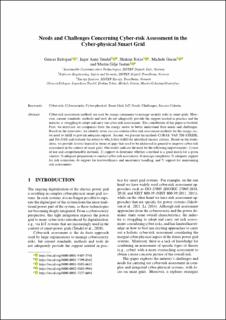| dc.contributor.author | Erdogan, Gencer | |
| dc.contributor.author | Tøndel, Inger Anne | |
| dc.contributor.author | Tokas, Shukun | |
| dc.contributor.author | Garau, Michele | |
| dc.contributor.author | Jaatun, Martin Gilje | |
| dc.date.accessioned | 2022-10-14T13:20:32Z | |
| dc.date.available | 2022-10-14T13:20:32Z | |
| dc.date.created | 2022-08-26T18:46:22Z | |
| dc.date.issued | 2022 | |
| dc.identifier.citation | Proceedings of the 17th International Conference on Software Technologies (ICSOFT 2022). 2022, 21-32. | en_US |
| dc.identifier.isbn | 978-989-758-588-3 | |
| dc.identifier.uri | https://hdl.handle.net/11250/3026191 | |
| dc.description.abstract | Cyber-risk assessment methods are used by energy companies to manage security risks in smart grids. However, current standards, methods and tools do not adequately provide the support needed in practice and the industry is struggling to adopt and carry out cyber-risk assessments. The contribution of this paper is twofold. First, we interview six companies from the energy sector to better understand their needs and challenges. Based on the interviews, we identify seven success criteria cyber-risk assessment methods for the energy sector need to fulfill to provide adequate support. Second, we present the methods CORAS, VAF, TM-STRIDE, and DA-SAN and evaluate the extent to which they fulfill the identified success criteria. Based on the evaluation, we provide lessons learned in terms of gaps that need to be addressed in general to improve cyber-risk assessment in the context of smart grids. Our results indicate the need for the following improvements: 1) ease of use and comprehensible m ethods, 2) support to determine whether a method is a good match for a given context, 3) adequate preparation to conduct cyber-risk assessment, 4) manage complexity, 5) adequate support for risk estimation, 6) support for trustworthiness and uncertainty handling, and 7) support for maintaining risk assessments. | en_US |
| dc.language.iso | eng | en_US |
| dc.publisher | SciTePress | en_US |
| dc.relation.ispartof | Proceedings of the 17th International Conference on Software Technologies (ICSOFT 2022) | |
| dc.rights | Attribution-NonCommercial-NoDerivatives 4.0 Internasjonal | * |
| dc.rights.uri | http://creativecommons.org/licenses/by-nc-nd/4.0/deed.no | * |
| dc.subject | Cyber-risk | en_US |
| dc.subject | Cybersecurity | en_US |
| dc.subject | Cyber-physical | en_US |
| dc.subject | Smart grid | en_US |
| dc.subject | IoT | en_US |
| dc.subject | Needs | en_US |
| dc.subject | Challenges | en_US |
| dc.subject | Success criteria | en_US |
| dc.title | Needs and Challenges Concerning Cyber-Risk Assessment in the Cyber-Physical Smart Grid | en_US |
| dc.title.alternative | Needs and Challenges Concerning Cyber-Risk Assessment in the Cyber-Physical Smart Grid | en_US |
| dc.type | Chapter | en_US |
| dc.description.version | acceptedVersion | en_US |
| dc.source.pagenumber | 21-32 | en_US |
| dc.identifier.doi | 10.5220/0011137100003266 | |
| dc.identifier.cristin | 2046396 | |
| dc.relation.project | Norges forskningsråd: 257626 | en_US |
| cristin.ispublished | true | |
| cristin.fulltext | postprint | |
| cristin.qualitycode | 1 | |

